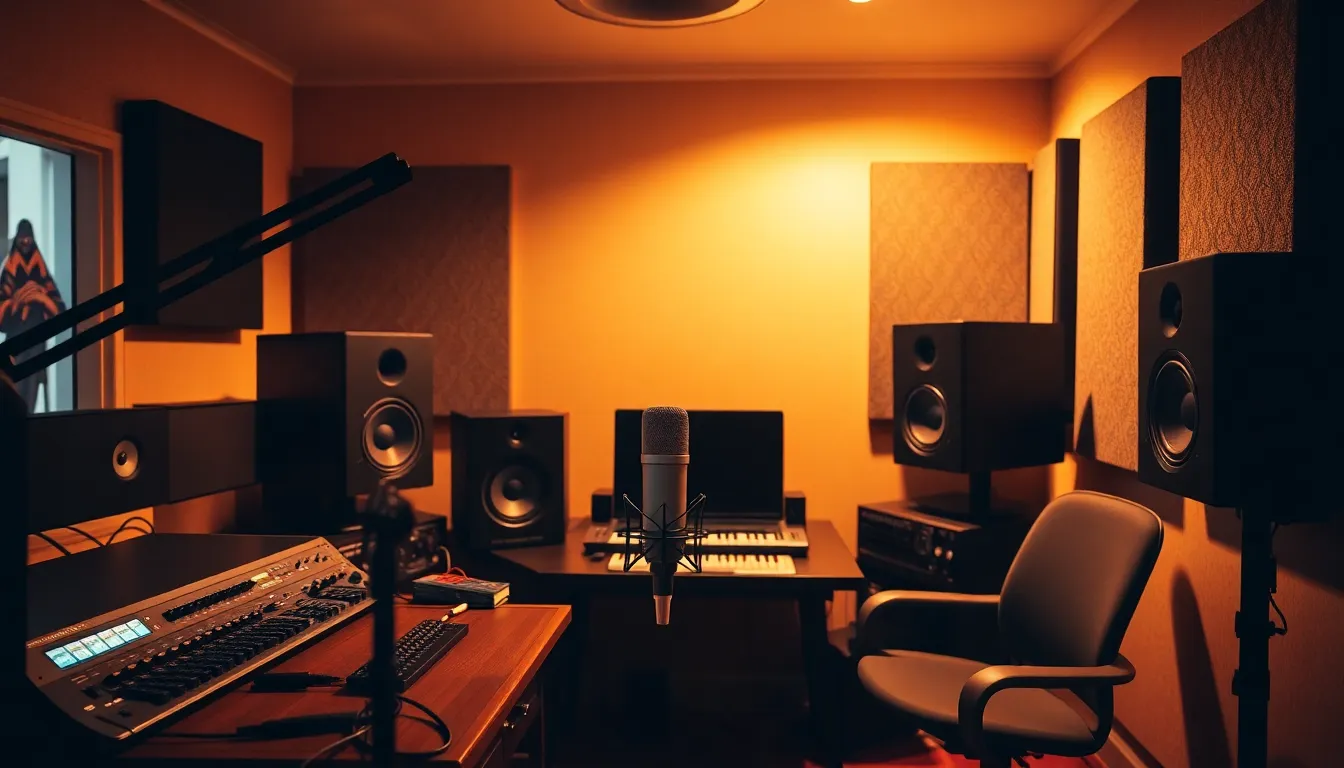In a world where creativity knows no bounds, setting up a home studio is the ultimate game changer. Imagine transforming that cozy corner of your living room into a buzzing hub of inspiration where ideas flow as freely as coffee. Whether it’s for music, art, or podcasting, a well-thought-out home studio can be the difference between a half-hearted attempt and a masterpiece that wows the world.
Table of Contents
ToggleOverview of Home Studio Setup
A home studio setup serves as a versatile space for creativity. These environments cater to various artistic pursuits including music production, graphic design, and podcasting. Essential elements contribute to a functional studio. For instance, efficient acoustic treatment improves sound quality, while proper lighting enhances visual clarity.
Space plays a crucial role. It needs adequate room for equipment and movement. Artists often choose rooms with minimal outside noise to maintain focus. Choosing appropriate furniture also matters. Desks designed for keyboards and sound mixing enhance ergonomics and efficiency.
Technology is a vital component. High-quality microphones, speakers, and software significantly improve production quality. Investing in reliable audio interfaces bridges the gap between instruments and computers, streamlining the workflow. For visual projects, consider high-resolution monitors that accurately display colors and details.
Organization impacts productivity. Storage solutions for cables and instruments eliminate clutter. Color-coded labels and designated areas for tools can simplify access and save time. Many creators also benefit from mood boards that inspire ideas and keep goals visible.
Lastly, personal touches make the space inviting. Adding artwork or plants fosters a positive atmosphere. Ultimately, a well-designed home studio promotes creativity and increases the potential for impressive outcomes across various artistic media.
Essential Equipment for Home Studio

Setting up a home studio requires specific equipment to enhance productivity and creativity. Key items include an audio interface, microphones, and studio monitors.
Audio Interface
An audio interface connects microphones and instruments to a computer. It converts analog audio signals into digital format, ensuring high-quality sound for recording. Various models, such as Focusrite Scarlett or PreSonus AudioBox, offer different features for diverse needs. A good interface typically includes multiple inputs, low-latency performance, and quality preamps. Depending on the size of the studio, choosing one with multiple outputs can facilitate connecting various equipment.
Microphones
Microphones capture sound and play a crucial role in recording quality. Dynamic microphones, like Shure SM58, are perfect for vocals and live performances. Condenser microphones, such as Audio-Technica AT2020, excel in studio recording due to their sensitivity and detail. When selecting microphones, consider factors like pickup pattern, frequency response, and budget. It’s important to have a versatile selection to accommodate different types of recordings, from vocals to instruments.
Studio Monitors
Studio monitors provide accurate sound reproduction for mixing and mastering. Brands like Yamaha and KRK offer monitors with various features suited for different studio sizes. Essential characteristics include flat frequency response and minimal distortion, which aid in creating clear mixes. Proper placement of monitors can significantly impact sound quality, so positioning them at ear level and following the equilateral triangle setup is crucial. Investing in quality monitors enhances the listening experience and ensures the final product translates well across playback systems.
Acoustic Treatment Techniques
Acoustic treatment techniques enhance sound quality in a home studio. Various methods improve audio performance and minimize unwanted noise.
Soundproofing
Soundproofing minimizes external noise interference. To effectively reduce sound leakage, one can use thick walls, insulated windows, and soundproof doors. Adding mass to walls with soundproofing materials creates more sound barriers. Acoustic caulk seals gaps to prevent sound from passing through. Many studios implement double wall structures for optimal isolation. This method ensures a focused recording environment for music and vocal performances.
Sound Absorption
Sound absorption improves audio clarity by reducing reflections. Soft materials, such as foam panels, carpets, and curtains, effectively dampen excess sound. Strategic placement of acoustic panels on walls decreases echo and improves recording quality. Bass traps in corners help control low-frequency sounds, ensuring balanced audio. Utilizing diffusers can maintain a pleasant sound without harsh reflections. Choosing the right combinations allows for a well-rounded acoustic environment.
Software and Tools for Home Studio
Selecting the right software and tools significantly enhances the home studio experience. A good combination not only improves creativity but also improves overall production quality.
Digital Audio Workstations (DAWs)
Digital Audio Workstations stand at the core of music production. They manage recording, editing, and mixing of audio. Popular options include Ableton Live, Logic Pro, and Pro Tools, each catering to different workflows and preferences. Flexible audio routing and powerful editing features exist in these platforms, allowing users to customize their projects. DAWs typically come equipped with built-in plugins and virtual instruments, expanding creative possibilities. They support various audio formats, making it easy to collaborate with others. Choosing the right DAW can streamline processes and elevate the overall recording experience.
Plugins and VSTs
Plugins and VSTs significantly expand the capabilities of DAWs. They offer a plethora of effects and virtual instruments, enhancing sound design options. Common types include equalizers, compressors, and reverb plugins, each serving distinct purposes in audio production. High-quality VSTs can emulate real instruments or introduce unique sounds into projects. Examples like Serum for synthesis and Waves for mixing dominate the market, providing professional sound quality. Paid and free options are available, ensuring accessibility for various budgets. Integrating plugins and VSTs into workflows enriches the sonic palette and elevates the final mix.
Tips for Optimizing Your Home Studio
Creating an efficient home studio requires attention to detail in ergonomics, layout, and organization.
Ergonomics and Layout
A well-considered layout fosters productivity and creativity. Position the desk at a comfortable height to maintain good posture during long sessions. Arrange equipment within easy reach to reduce strain; this includes monitors, mixers, and keyboards. Use adjustable furniture features to accommodate different tasks, whether mixing sound or editing video. Footrests and adjustable chairs enhance comfort, allowing for extended periods of work without discomfort. Ensure that lighting is sufficient but not harsh; this prevents eye strain while providing clarity for visuals and workspace. Prioritizing these design elements improves focus and ultimately enhances the creative process.
Cable Management
Effective cable management prevents clutter and reduces distractions. Use cable trays, clips, or ties to organize cords neatly along walls or desks. Label each cable for easy identification, simplifying connection and disconnection during sessions. Avoid tangling by grouping cables based on their function, separating audio cables from power cords. Implementing cable sleeves or channels conceals wires and keeps the workspace clean. Regularly inspect cables for wear and tear to avoid equipment damage or connectivity issues. Establishing a tidy space promotes an organized atmosphere, encouraging a seamless creative workflow.
Creating a home studio is an exciting journey that opens doors to endless creative possibilities. By thoughtfully designing the space and investing in the right equipment, anyone can cultivate an environment that inspires and enhances artistic expression. Prioritizing elements like acoustic treatment, proper lighting, and ergonomic furniture ensures a functional workspace tailored to individual needs.
Incorporating personal touches can further elevate the atmosphere, making it a welcoming haven for creativity. With the right tools and organization, a home studio becomes more than just a workspace; it transforms into a sanctuary where ideas flourish and impressive outcomes emerge. Embracing this setup can lead to remarkable achievements across various artistic pursuits.




